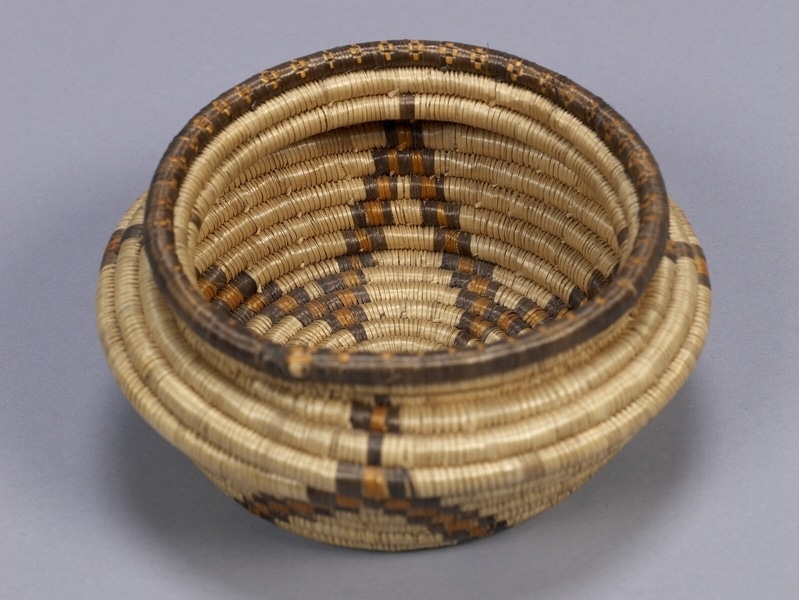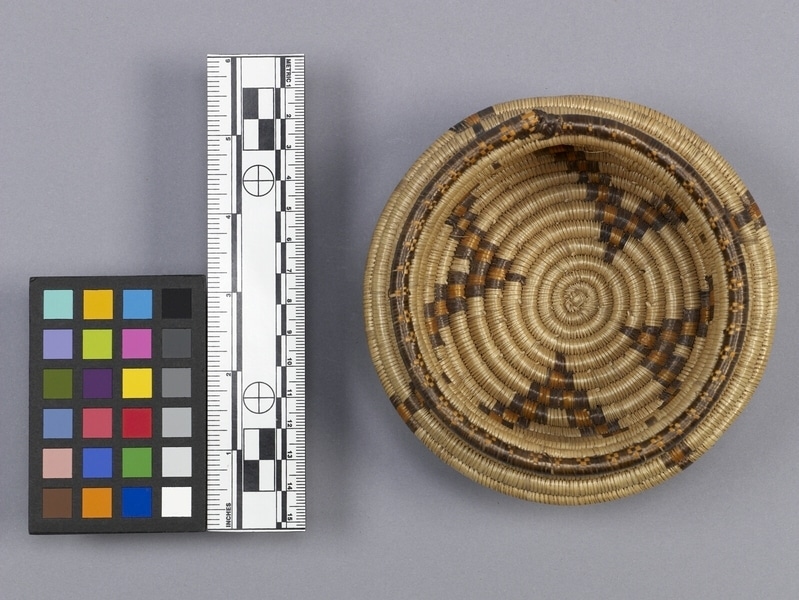Basket Item Number: K4.337 from the MOA: University of British Columbia



Description
A coiled basket with the shape of a compressed jar that has an inverted lip. The main design consists of a four petal flower shape from the centre bottom up the sides with an orange and a dark brown outline on a natural coloured background. The rim has a design which consists of red-brown crosses with dark brown middles on a dark brown background.
History Of Use
Grass weaving is done by both men and women, but baskets are traditionally woven by most women. Geometric and floral patterns are common in Ovimbundu basketry.
Specific Techniques
The dyes used in this basket are dark brown and amber-yellow. Yellow dye is made from roots of wild rhubarb (ocilunguluila). The roots are pounded and placed in cold water with the grasses used to create the coils. Afterwards, the mixture is placed in a fire to boil for half an hour, turning the grasses amber-yellow. To make dark brown dye, the maker could have made brown dye or made a light black dye. To create brown dye, yellow and red dye are mixed together; shade of brown determined by ratio of red and yellow dyes. Red dye is made by cooking leaves from an evava plant and boiling them in water with bark of the ukondo tree. After they are sufficiently simmered, they are mixed with ash and buried. Black dye is made when evava leaves are mixed in an iron solution; iron is obtained from stagnant muddy pools. Grass are placed into the evava-iron solution and boiled to darken. It can be darkened further by boiling the solution again and adding pounded ungalo leaves.
Item History
- Made in Angola
- Collected during 1950
- Owned by Anne E. Copithorne before November 14, 1973
- Received from Anne E. Copithorne (Donor) on November 14, 1973
What
- Name
- Basket
- Identification Number
- K4.337
- Type of Item
- basket
- Material
- plant fibre
- Manufacturing Technique
- coiled
- Overall
- height 6.4 cm, diameter 13.4 cm
Who
- Culture
- Ovimbundu
- Previous Owner
- Anne E. Copithorne
- Received from
- Anne E. Copithorne (Donor)
Where
- Holding Institution
- MOA: University of British Columbia
- Made in
- Angola
When
- Collection Date
- during 1950
- Ownership Date
- before November 14, 1973
- Acquisition Date
- on November 14, 1973
Other
- Item Classes
- basketry
- Condition
- fair
- Current Location
- Case 100
- Accession Number
- 0251/0066